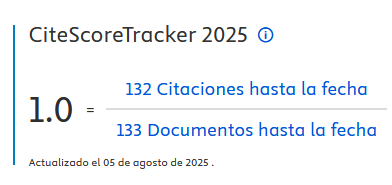El Modelo de Asimilación como un Modelo Integrador sobre el Cambio Terapéutico
DOI:
https://doi.org/10.33898/rdp.v28i108.204Palabras clave:
modelo de asimilación, voz, APES, asimilación integrativaResumen
Este trabajo se centra en el modelo de asimilación de experiencias problemáticas. Dicho modelo es un modelo de corte integrador que nos permite estudiar el proceso de cambio en cualquier enfoque terapéutico y con diversos tipos de pacientes y sujetos. Por ello, expondremos, en primer lugar, los principales conceptos y características del modelo, como por ejemplo, qué significa asimilar, el concepto de voz y de voz no dominante y voz dominante, junto con la descripción de la Escala de Asimilación de Experiencias Problemáticas. A continuación, se describirán los resultados más destacados alcanzados en tres áreas principales: el estudio del proceso de cambio en pacientes; el proceso irregular y dentado de asimilación y el papel que tiene el terapeuta en dicho proceso. Esta última cuestión se relaciona con el concepto de responsividad y con el concepto de integración asimilativa.Descargas
Citas
Allepuz, A., Caro, I., Rojo, I. y Yera, A. (2014). La asimilación de experiencias problemáticas a través denarraciones: un estudio de caso. Anales de Psicología, 30, 56-69. doi: 10.6018/analesps.30.1.153991
Barkham, M., Stiles, W. B., Hardy, G. E. y Field, S. D. (1996). The assimilation model: theory, research andpractical guidelines. En W. Dryden (Ed.), Research in counselling and psychotherapy, (pp. 1-24). Londres,Reino Unido: Sage Publications.
Brinegar, M.G., Salvi, L.M., Stiles, W., y Greenberg, L.S. (2006). Building a meaning bridge: Therapeutic progressfrom problem formulation to understanding. Journal of Counselling Psychology, 53, 165-180. doi: 10.1037/0022-0167.53.2.165
Caro, I. (2003a). La resolución de experiencias problemáticas en la terapia lingüística de evaluación según elmodelo de asimilación. Boletínde Psicología, 79, 31-57.
Caro, I. (2003b). La resolución de experiencias problemáticas en la terapia lingüística de evaluación según elmodelo de asimilación. El análisis de Silvia. Boletín de Psicología, 79, 59-84.
Caro, I. (2006). The assimilation of problematic experiences in the context of a therapeutic failure. PsychotherapyResearch, 16, 436-452. doi:10.1080/10503300600743897
Caro, I. (2007). La asimilación de experiencias problemáticas en la terapia lingüística de evaluación: ¿Cómo asimilóMaría la sensación de ser una carga? BoletíndePsicología, 89, 47-73.
Caro, I. (2008). Assimilation of problematic experiences: A case study. Journal ofConstructivistPsychology, 21,151-172. doi: 0.1080/10720530701853735
Caro, I. (2011). El cambio terapéutico a través del modelo de asimilación: su aplicación en la terapia lingüística deevaluación. Revista de Psicopatología y Psicología Clínica, 16, 169-188.
Caro, I., Pérez Ruiz, S. y Llorens Aguilar, S. (2014). Therapeutic activities and the assimilation model: Apreliminary exploratory study on the Insight stage. Counselling Psychology Quarterly, 27, 217-240. doi:10.1080/09515070. 2013.877419
Caro, I. y Stiles, W.B. (2013). Irregular assimilation progress: Reasons for setbacks in the context of linguistictherapy of evaluation. Psychotherapy Research, 23, 35-53. doi: 10.1080/10503307.2012.721938
Caro, I., Stiles, W.B. y Pérez, S. (2016) Therapist activities preceding setbacks in the assimilation process,Psychotherapy Research, 26, 653-664. doi: 10.1080/10503307.2015.1104422
Caro, I. y Stiles, W.B. (en prensa). Therapist activities preceding therapy setbacks in a poor-outcome case.Counselling Psychology Quarterly. Recuperado de: doi: 10.1080/09515070.2017.1355295
Deter, N. B., Llewelyn, S., Hardy, G. E., Barkham, M. y Stiles, W. B. (2006). Assimilation in good – and poor –outcome cases of very brief psychotherapy for mild depression: an initial comparison. PsychotherapyResearch, 16, 393-407. doi:10.1080/10503300500294728
Goldsmith, J. Z., Mosher, J. K., Stiles, W. B., y Greenberg, L. S. (2008). Speaking with the client‘s voices: Howa person-centered therapist used reflections to facilitate assimilation. Person-Centered and ExperientialPsychotherapies, 7, 155-172. doi: 10.1080/14779757.2008.9688462
Hardy, G., Aldridge, J., Davidson, C., Rowe, C., Reilly, S., y Shapiro, D. A. (1999). Therapist responsiveness toclient attachment styles and issues observed in client – identified significant events in psychodynamic –interpersonal psychotherapy. PsychotherapyResearch, 9, 36-53. doi: 10.1093/ptr/9.1.36
Henry, H., Stiles, W.B., y Biran, M.W. (2005). Loss and mourning in immigration: Using the assimilation modelto assess continuing bonds with native culture. CounsellingPsychologyQuarterly, 18, 109-119. doi:10.1080/09515070500136819
Hermans, H.J.M., Kempen, H.J.G., y van Loon, R.P.P. (1992). The dialogical self: Beyond individualism andrationalism. AmericanPsychologist, 47, 23-33. doi: 10.1037/0003-066X.47.1.23
Honos-Webb, L., y Stiles, W.B. (1998). Reformulation of assimilation analysis in terms of voices. Psychotherapy,35, 23-33. doi: 10.1037/h0087682
Honos-Webb, L., y Stiles, W.B. (2002). Assimilative integration and responsive use of the assimilation model.Journal of Psychotherapy Integration, 12, 406-420. doi: 10.1037/1053-0479.12.4.406
Honos-Webb, L., Surko, M., Stiles, W.B., y Greenberg, L.S. (1999). Assimilation of voices in psychotherapy: thecase of Jan. Journal of Counseling Psychology, 46, 448-460. doi: 10.1037/0022-0167.46.4.448
Honos-Webb, L., Stiles, W.B., Greenberg, L.S., y Goldman, R. (1998). Assimilation analysis of process-experiential psychotherapy: A comparison of two cases. Psychotherapy Research, 8, 264-286.
Humphreys, C.L., Rubin, J.S., Knudson, R.M., y Stiles, W.B. (2005). The assimilation of anger in a case ofdissociative identity disorder. Counselling Psychology Quarterly, 18, 121-132. doi: 10.1080/09515070500136488
Kramer, U. & Stiles, W. B. (2015). The responsiveness problem in psychotherapy: A review of proposed solutions.Clinical Psychology: Science and Practice, 22, 277- 295. doi: 10.1111/cpsp.12107
Leiman, M. y Stiles, W. B. (2001). Dialogical sequence analysis and the zone of proximal development asconceptual enhancements to the assimilation model: the case of Jan revisited. Psychotherapy Research, 11,311-330. doi: 10.1080/ 713663986
Mendes, I., Rosa, C., Stiles, W.B., Caro, I., Gomes, P., Bato, I. y Salgado, J. (2016). Setbacks in the process ofassimilation of problematic experiences in two cases of emotion-focused therapy for depression,Psychotherapy Research, 26, 638-652, doi:10.1080/10503307.2015.1136443
Meystre, C. (2010). Assimilation process in a psychotherapy with a client presenting schizoid personality disorder.Schweizer Archiv für Neurologie und Psychiatrie, 161, 128-134.
Meystre, C., Kramer, U., Roten, Y., Despland, J.N., y Stiles, W. (2014). How psychotherapeutic exchanges becomeresponsive: A theory-building case study in the framework of the assimilation model. Counselling andPsychotherapy Research, 14, 29-41. doi: 10.1080/14733145. 2013.782056
Mosher, J. K., Goldsmith, J. Z., Stiles, W.B. y Greenberg, L. S. (2008). Assimilation of two critic voices in a person-centered therapy for depression. Person-Centered and Experiential Psychotherapies, 7, 1-19. doi: 10.1080/14779757.2008.9688449
Mosher, J.K. y Stiles, W.B. (2009). Clients’ assimilation of experiences of their therapists. Psychotherapy, 46, 432-447. doi: 10.1037/a0017955
Osatuke, K., Glick, M. J., Stiles, W. B., Greenberg, L. S., Shapiro, D. A., y Barkham, M. (2005). Temporal patternsof improvement in client-centred therapy and cognitive-behaviour therapy. Counselling PsychologyQuarterly, 18, 95-108. doi:10.1080/09515070500136900
Osatuke, K., Mosher, J. K., Goldsmith, J. Z. y Stiles, W. B. (2007). Submissive voices dominate in depression:Assimilation analysis of a helpful session. Journal of Clinical Psychology, 63, 153-164. doi: 10.1002/jclp.20338
Osatuke, K., Reid, M., Stiles, W. B., Kasckow, S. Z., y Mohamed, S. (2011). Narrative evolution and assimilationof problematic experiences in a case of pharmacotherapy for schizophrenia. PsychotherapyResearch, 21,41-53. doi:10.1080/10503307.2010.508760
Osatuke, K. y Stiles, W. B. (2006). Problematic internal voices in clients with borderline features: an elaborationof the assimilation model. Journal of ConstructivistPsychology, 19, 287-319. doi: 10.1080/10720530600691699
Osatuke, K., Stiles, W.B., Barkham, M., Hardy, G.E., y Shapiro, D.A. (2011). Relationship between mental statesin depression: The assimilation model perspective. PsychiatryResearch, 190, 52-59. doi: 10.1016/j.psychres.2010.11.001
Penttinen, H. & Wahlström, J. (2013). Progress in assimilation of problematic experience in group therapy for socialphobia: A subgroup analysis. Journal of Contemporary Psychotherapy,43, 123–132. doi: 10.1007/s10879-012-9227-3
Pérez, S. y Caro Gabalda, I. (2016). Assimilation of problematic experiences in brief strategic therapy: Olivia andher fear of dying. Estudios de Psicología, 37, 16-31. doi: 10.1080/02109395.2016.1204785
Reid, M. y Osatuke, K. (2006). Acknowledging problematic voices: processes occurring at early stages of conflictassimilation in patients with functional somatic disorder. Psychology and Psychotherapy,79, 539-555. doi:10.1348/147608305X90467
Ribeiro, A. P., Braga, C., Stiles, W.B., Teixeira, P., Gonçalves, M.M., y Ribeiro, E. (2016). Therapist interventionsand client ambivalence in two cases of narrative therapy for depression, Psychotherapy Research, 26, 681-693. doi:10.1080/10503307.2016.1197439
Ribeiro, E., Cunha, C., Teixeira, A.S., Stiles, W.B., Pires, N., Santos, B., Basto, I., y Salgado, J. (2016). Therapeuticcollaboration and the assimilation of problematic experiences in emotion-focused therapy for depression:Comparison of two cases. PsychotherapyResearch, 26, 665-680, doi:10.1080/10503307.2016.1208853
Ribeiro, E., Ribeiro, A.P., Gonçalves, M.M., Horvath, A.O., y Stiles, W.B. (2013). How collaboration in therapybecomes therapeutic: The therapeutic collaboration coding system. Psychology and Psychotherapy:Theory, Research and Practice, 86, 1-21. doi: 10.1111/j.2044-8341.2012.02066
Stiles, W. B. (2001). Assimilation of problematic experiences. Psychotherapy, 38, 462 - 465. doi: 10.1037/0033-3204.38.4.462
Stiles, W.B. (2002). Assimilation of problematic experiences. En J.C. Norcross (Ed.), Psychotherapy relationshipsthat works (pp. 357-365). Cary: Oxford University Press.
Stiles, W.B. (2005). Extending the assimilation of problematic experiences scale: commentary on the special issue.Counselling Psychology Quarterly, 18, 85-93. doi: 10.1080/09515070500136868
Stiles, W.B. (2007). Theory-building case studies of counselling and psychotherapy. Counselling and PsychotherapyResearch. 7, 122-127. doi: 10.1080/14733140701356742
Stiles, W. B. (2009). Responsiveness as an obstacle for psychotherapy outcome research: It ́s worse than you think.Clinical Psychology Science and Practice,16, 86-91. doi: 10.1111/j.1468-2850.2009.01148.x
Stiles, W. B., Caro, I., y Ribeiro, E. (2016). Exceeding the therapeutic zone of proximal development as a clinicalerror. Psychotherapy, 53, 268-272. doi: 10.1037/pst0000061
Stiles, W.B., Barkham, M., Shapiro, D.A. y Firth-Cozens, J. (1992). Treatment order and thematic continuitybetween contrasting psychotherapies: Exploring an implication of the assimilation model. PsychotherapyResearch, 2, 112-124. doi: 10.1080/10503309212331332894
Stiles, W.B., Elliott, R., Llewelyn, S., Firth-Cozens, J., Margison, F.R., Shapiro, D.A., y Hardy, G. (1990).Assimilation of problematic experiences by clients in psychotherapy. Psychotherapy, 27, 411-420. doi:10.1037/0033-3204.27.3.411
Stiles, W.B., Honos-Webb, L., y Lani, J.A. (1999). Some functions of narrative in the assimilation of problematicexperiences. Journal of Clinical Psychology, 55, 1213-1226. doi: 10.1002/(SICI)1097-4679(199910)55:10<1213::AID-JCLP4>3.0.CO;2-1
Stiles, W. B., Honos-Webb, L. y Surko, M. (1998). Responsiveness in psychotherapy. Clinical Psychology: Scienceand Practice, 5, 439-458. doi: 10.1111/j.1468-2850.1998.tb00166.x
Stiles, W. B., Leiman, M., Shapiro, D. A., Hardy, G. E., Barkham, M., Detert, N.B. y Llewelyn, S. P. (2006). Whatdoes the first exchange tell? Dialogical sequence analysis and assimilation in very brief therapy. PsychotherapyResearch, 16, 408-421. doi: 10.1080/10503300500288829
Stiles, W.B., Morrison, L.A., Haw, S.K., Harper, H., Shapiro, D.A., y Firth-Cozens, J., (1991). Longitudinal studyof assimilation in exploratory psychotherapy. Psychotherapy, 28, 105-206. doi: 10.1037/0033-3204.28.2.195
Vañó, R., & Caro, I. (2015). Sujeto X. Análisis de narraciones a través del modelo de asimilación en la esquizofrenia.Boletín de Psicología, 113, 49-70.
Descargas
Publicado
Cómo citar
Número
Sección
Licencia
Los autores/as que publiquen en esta revista aceptan las siguientes condiciones:
- Los autores/as conservan los derechos de autor y ceden a la revista el derecho de la primera publicación, con el trabajo registrado con la Creative Commons CC-BY-NC 4.0 Internacional, que permite a terceros citar el texto y usarlo sin alterarlo y sin beneficio económico, siempre que mencionen la autoría del trabajo y la primera publicación en esta revista.
- Los autores/as pueden realizar otros acuerdos contractuales independientes y adicionales para la distribución no exclusiva de la versión del artículo publicado en esta revista (p. ej., incluirlo en un repositorio institucional o publicarlo en un libro), siempre que indiquen claramente que el trabajo se publicó por primera vez en esta revista.
- Las opiniones expresadas en los trabajos son responsabilidad única de los/as autores/as, no reflejando en ningún caso las opiniones o políticas científicas de la revista.














